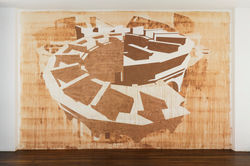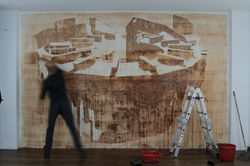 |  |  |  |
|---|---|---|---|
 |  |  |  |
 |  |  |  |
 |
BARRENA
Estudio del artista.
2013
Barrena es una obra que se hace y se deshace en la pared, generando así nuevas imágenes, insistiendo, por un lado, en el paso ineludible del tiempo, y, por otro, creando una especie de arqueología de la imagen, donde memoria y actualidad se conjugan armoniosamente. El principio mismo de esta pintura es el des-ocultamiento, y se realiza en la pared con barro que el artista extrajo de canteras de ladrillos. Figuras arquitectónicas, que nos recuerdan de una u otra manera construcciones históricas, se realizan en la pared, y luego se borran con ayuda del agua, dejando una huella que se amalgama con otras formas similares. Esta superposición de imágenes abre un espectro amplio de tonalidades que permiten velar y develar algo que toca muy de cerca el misterio, el enigma. Alétheia es una palabra griega que resume esta acción, develar algo pero mediante el ocultamiento. “Como una mariposa cuando bate sus alas”, dice Franco. Este develar, ocultando y des-ocultando, deja al final del proceso una obra-huella, como insistiendo en que el tiempo es también memoria, y no solamente fuga.
 |  |  |  |
|---|---|---|---|
 |  |  |  |
 |
Esto es lo que sucede en Barrena (Octubre 2013 - Febrero de 2014). Esta obra, cuyo título, según el artista, se aproxima a la palabra barreña (vasija de barro) tiene su origen en Los desposorios de la Virgen de Rafael Sanzio, pintada en 1504. La construcción que está en el fondo del cuadro sirve de pre-texto a Jaime Franco para extraer una fracción de la parte inferior, eliminando algunos detalles. Esa figura arquitectónica desprovista de la cúpula gira en el espacio creando una sensación de movimiento, donde la mirada puede adentrarse en el problema que ya los artistas del Renacimiento se planteaban: el arte (la pintura) se concibe en relación con el espacio arquitectónico.
Ricardo Arcos-Palma
Video by iconsmind.com from the Noun Project
BARRENA
Artist's studio.
2013
Barrena is a work done and undone on a big wall in a process that generates new images that convey, on the one hand, the inevitable passage of time and, on the other, the creation of a kind of archeology of the image in which memory and the present come harmoniously together. The same principle of this painting and drawing is the un-concealment, and it takes place on the wall of mud that the artist picks in several parts of the country. Architectural drawings that somehow remind us of historic buildings are created on the wall and then erased with water, leaving a trace behind that amalgamates with other similar forms. This superimposition of images opens a wide spectrum of tonalities that allow the veiling and unveiling of something that is very close to a mystery: an enigma. This is essentially the same as Alétheia: to uncover something but through concealment, "as when a butterfly flaps its wings," says Franco. This revealing, hiding and un-hiding leaves a work-trace at the end of the process, as if insisting that time is also memory and not just a fleeting occurrence.
This is what happened in Barrena (October 2013 - February 2014). In this work whose title, according to the artist, is associated with the word "barreña" (clay pot), has its origins in The Marriage of the Virgin (1054) by Raphael Sanzio. The construction in the background of painting could serve as pre-text to Jaime Franco to extract a fraction from the lower part, thus eliminating some details. This figure devoid of its architectural dome rotates in space, creating a sense of movement, allowing the gaze to delve deep into a problem that also Renaissance artists wondered about: namely, that art—painting in particular—is conceived in relation to the architectural space.
Ricardo Arcos-Palma


